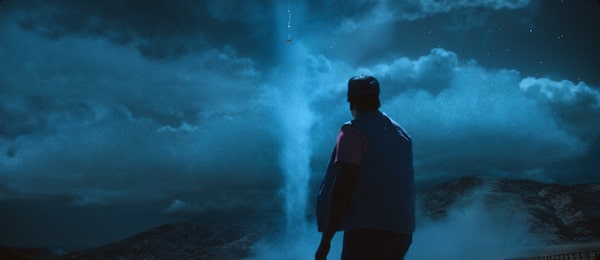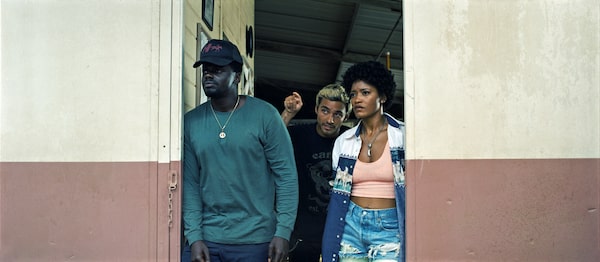
Daniel Kaluuya as O.J. Haywood in Nope.Universal Pictures
Nope
Written and directed by Jordan Peele
Starring Daniel Kaluuya, Keke Palmer and Brandon Perea
Classification R; 135 minutes
Opens in theatres July 22
It is a peculiar irony that the history of American filmmaking finds its beginnings in images of Black life. Any first-year film student worth their salt can tell you of Eadweard Muybridge, a bookseller and printer by trade whose experiments in time-lapse photography were instrumental in the development of motion pictures.
Most notable of these was his 1878 series, The Horse in Motion, which documented the sequential movement of a galloping horse and offers its most familiar images in the form of mare Sallie Gardner ridden by a Black jockey known only as G. Domm. While Muybridge’s work stands as a testament to the spectacle and celebration that surrounded the advent of moving pictures at the turn of the 20th century, so, too, does it speak to the erasure of its very means of production.
It’s this suppressed history and the contradictions that shape it that writer-director Jordan Peele (Get Out, Us) works forward from in his much-anticipated thriller, Nope. Daniel Kaluuya and Keke Palmer star here as O.J. and Emerald Haywood, siblings who couldn’t differ more in temperament and who are having difficulties maintaining their formerly lucrative family business, Haywood’s Hollywood Horses. The only Black-owned horse trainers in Hollywood, the Haywoods are descended from Muybridge’s same Black jockey to whom Peele offers a much more living history and lineage.

Nope is the third film by writer-director Jordan Peele.Universal Pictures
Mainstays on big-budget film and television productions in need of animal handling, O.J. and Emerald struggle to fill the shoes of their recently passed father, Otis Haywood Sr. (Keith David), who handed the wrangling trade and its sprawling ranch down to them just as it had been inherited by generations before. While rich in legacy, the Haywoods and their work are largely made invisible and wholly subsumed to the wills and pageantry of moviemaking; much like their history-making forebear, they are unacknowledged even as they stand in plain sight.
Reticent to admit defeat, O.J. has been discreetly selling Haywood horses (with the intention of buying them back) to their nearest neighbour, Ricky “Jupe” Park (Steven Yeun), a former child star who owns a schlocky, Western-themed tourist attraction. Further bolstering these losses is the fact that Haywood horses have been quietly, mysteriously disappearing.
While Nope is initially eager to meet our expectations as to what or who the culprit may be, the film’s real work lies in the way it attempts to destabilize these same assumptions while also grounding us within Peele’s now characteristic impulse toward nostalgia. Just three films into his career, it is clear that Peele is not averse to the creature comforts that come with playing with the rites and rituals of genre filmmaking.
Within these shakeups is Peele’s choice to shape the film into loose chapters. Titled after the names of Haywood horses, the segments feel divided less by internal logic, plot or thematics, but rather by a desire to point us toward an unsettling of traditional narrative structure. The chapters complicate the very experience of watching – and in a film full of ambition, it is perhaps the least successful element. In grappling with the give and take of form and story, Peele can’t seem to find the sweet spot between convention and experimentation, which leads to an unfortunate muddying of both philosophies.

It is the slippage between curiosity and obsession, entertainment and exploitation, horror and pleasure, that Peele seems interested in above all here.Universal Pictures
While the tone and feel of Nope is wonderfully atmospheric and expansive, it also feels as if it comes at the expense of characters possessing deep interior lives or a story world that is well and evenly plotted. In many ways, the film feels like a loose assemblage of parts, a series of gestures toward something that can’t seem to reach the potential of its full expression. It is a Western sci-fi thriller that is so eager to play in all of its conceptual and referential sandboxes that it jumps to the next without fully exploring the one before it.
But, and perhaps this is an overcorrection from the didacticism of 2019′s Us, Nope is also the most metaphorical of Peele’s films. Privileged here are image and sound, with superb collaborations on cinematography and sound design levels revelling in the urgency and shape-shifting nature of awe and fear. In Nope’s best moments, we watch as characters cast their gaze upon the film’s own surreal novelties with deference or ego.
Ultimately, Nope is about the often brutal relations at work within the act of both seeing and being seen. Even the film’s opening moments skip with jarringly calm intent from a Biblical citation of Nahum 3:6, to Muybridge’s stop-motion sequence, and finally to a horrific chimpanzee attack evocative of ‘90s animal actor Travis and the media circus that followed his similarly fatal acts of aggression. It is no coincidence that O.J. and Emerald reference ways of image-making codified by daytime television, particularly the sensationalism that marked its cacophonous cultural presence in the 1980s and 1990s.
It is this slippage between curiosity and obsession, entertainment and exploitation, horror and pleasure, that Peele seems interested in above all here. Even as Nope struggles to synthesize all of its vast moving pieces, its critique in terms of the violence of sight and spectacle remains potent. Ever a student of his own lived media history, Peele is eager to set us within the regime and crisis of the visual: the instinct to look away and, even more damning, the urge not to.
Plan your screen time with the weekly What to Watch newsletter. Sign up today.